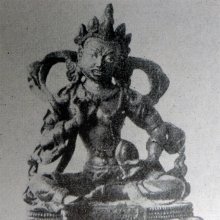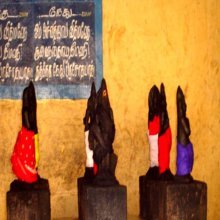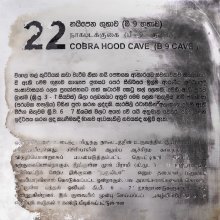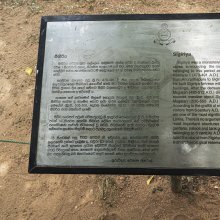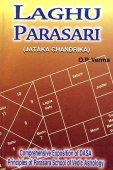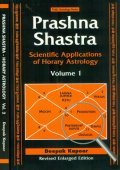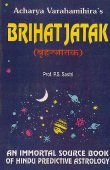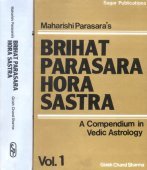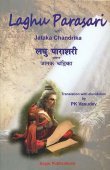Ketu, Keṭu, Kēṭu: 32 definitions
Introduction:
Ketu means something in Buddhism, Pali, Hinduism, Sanskrit, Jainism, Prakrit, the history of ancient India, Marathi, Hindi, Tamil. If you want to know the exact meaning, history, etymology or English translation of this term then check out the descriptions on this page. Add your comment or reference to a book if you want to contribute to this summary article.
Alternative spellings of this word include Kitu.
Images (photo gallery)
In Hinduism
Natyashastra (theatrics and dramaturgy)
Source: archive.org: The mirror of gesture (abhinaya-darpana)One of the Nava-graha (Hands that indicate the Nine Planets).—Ketu: left hand–Sūci, right hand–Ardha-patāka.
Source: Shodhganga: The significance of the mūla-beras (natya)Ketu (केतु) refers to a planet which can de depicted using hand gestures (hasta or mudrā).—When the left hand and the right hand assume sūcī-hasta and patāka-hasta respectively, it is considered as the hasta for the planet Ketu (dragon’s tail).

Natyashastra (नाट्यशास्त्र, nāṭyaśāstra) refers to both the ancient Indian tradition (shastra) of performing arts, (natya—theatrics, drama, dance, music), as well as the name of a Sanskrit work dealing with these subjects. It also teaches the rules for composing Dramatic plays (nataka), construction and performance of Theater, and Poetic works (kavya).
Purana and Itihasa (epic history)
Source: archive.org: Puranic Encyclopedia1) Ketu (केतु).—(KETUMĀN). A Dānava. He was the son of Kaśyapa (grandson of Brahmā and son of Marīci) by his wife Danu. This Asura, who exists in the shape of a planet had thirtythree brothers, i.e. Vipracitti, Śambara, Namuci, Pulomā, Asilomā, Keśī, Durjaya, Ayaśśiras, Aśvaśiras, Aśva, Śaṅku, Mahābala, Garga, Amūrdhan, Vegavān, Mānavān, Svarbhānu, Aśvapati, Vṛṣaparvan, Ajaka, Aśvagrīva, Sūkṣma, Tuhuṇḍa, Ekapāt, Ekacakra, Virūpākṣa, Harāhara, Nikumbha, Kapaṭa, Śarabha, Śalabha, Sūrya and Candramas. (Ādi Parva, Chapter 65).
But Ketu maintained closer relationship with Rāhu, a step-brother of his, being the son of Kaśyapa by another wife called Siṃhikā. Rāhu and Ketu are even today considered as inauspicious planets. Rāhu wears a half-moon and Ketu holds in his hands a sword and lamp. Amitaujas was Ketu reborn. (Ādi Parva, Chapter 67, Verse 11).
2) Ketu (केतु).—A great sage of ancient India. He attained salvation by self-study. (Śānti Parva, Chapter 26, Verse 7).
3) Ketu (केतु).—A synonym of Śiva. (Anuśāsana Parva, Chapter 17, Verse 38).
4) Ketu (केतु).—A King born in Bharata’s dyanasty. (Bhāgavata, 9th Skandha).
5) Ketu (केतु).—(DHŪMAKETU). The following story is told in Viṣṇudharmottara Purāṇa about the birth of Dhūmaketu.
Noting that the population on earth had increased abnormally Brahmā created a damsel called Mṛtyu and asked her to kill people. At this command of Brahmā she began crying, and from her tear drops various kinds of diseases originated at the sight of which she took to penance. Then Brahmā appeared and blessed her saying that no one would die because of her at which she heaved a great sigh of relief from which was born Ketu or Dhūmaketu.
Source: archive.org: Shiva Purana - English Translation1) Ketu (केतु) refers to “shooting meteors”, according to the Śivapurāṇa 2.3.15 (“The penance and reign of Tārakāsura”).—Accordingly, as Brahmā narrated: “[...] At the same time, several phenomena of evil portent forboding misery and distress happened, when the son of Varāṅgī was born making the gods miserable. O dear, the phenomena of three varieties indicating great calamity and terrifying the worlds occurred in the sky, heaven and earth. I shall narrate them. With a terrifying noise, thunderbolts fell along with comets; shooting meteors [i.e., ketu] rose up, making the world miserable. [...]”.
2) Ketu (केतु) refers to “banners” (suitable for great festivities), according to the Śivapurāṇa 2.3.37 (“The letter of betrothal is dispatched”).—Accordingly, as Himavat prepared the wedding of Menā and Śiva: “[...] Great festivities went on in the city. Banners (ketu), flags and festoons shone everywhere. The canopies hid the sunlight. Himavat welcomed them with great delight and reverence. The mountains and the rivers, the gents and the ladies were duly received. He housed them suitably in separate places. They were gratified with the amenities provided by Himavat”.
Source: Cologne Digital Sanskrit Dictionaries: The Purana Index1a) Ketu (केतु).—A son of Ṛṣabha.*
- * Bhāgavata-purāṇa V. 4. 10.
1b) One of the 100 sons of Vipracitta and Simhikā besides Rāhu (s.v.).*
- * Bhāgavata-purāṇa V. 23. 7; VI. 6. 37.
1c) A son of Tāmasa Manu.*
- * Bhāgavata-purāṇa VIII. 1. 27.
1d) A planet with a chariot of 8 horses, all green;1 in size one-fourth less than Bṛhaspati.2 Dhūmaketu, the first among the Ketus.3
- 1) Brahmāṇḍa-purāṇa II. 23. 90; 24. 136 and 39; Matsya-purāṇa 93. 10; 127. 11; Vāyu-purāṇa 52. 82; 111. 5; Viṣṇu-purāṇa II. 12. 23.
- 2) Matsya-purāṇa 128. 64.
- 3) Vāyu-purāṇa 53. 111.
1e) A son of Danu.*
- * Matsya-purāṇa 6. 18.
1f) The second son of Druhyu.*
- * Matsya-purāṇa 48. 6.
1g) One of the prāṇahinas of the king.*
- * Vāyu-purāṇa 57. 69.

The Purana (पुराण, purāṇas) refers to Sanskrit literature preserving ancient India’s vast cultural history, including historical legends, religious ceremonies, various arts and sciences. The eighteen mahapuranas total over 400,000 shlokas (metrical couplets) and date to at least several centuries BCE.
Shilpashastra (iconography)
Source: Shodhganga: The significance of the mūla-beras (śilpa)Ketu (केतु) refers to one of the Navagraha (“nine planetary divinities”), as defined according to texts dealing with śilpa (arts and crafs), known as śilpaśāstras.—Few planets are discussed with respect to the hastas in Bharatanatyam and iconography. In images, Ketu is found with two hands in añjali-hasta.

Shilpashastra (शिल्पशास्त्र, śilpaśāstra) represents the ancient Indian science (shastra) of creative arts (shilpa) such as sculpture, iconography and painting. Closely related to Vastushastra (architecture), they often share the same literature.
Jyotisha (astronomy and astrology)
Source: Wisdom Library: Brihat Samhita by VarahamihiraKetu (केतु) refers to the thirty-three “dark spots” (representing the sons of Rāhu are Tāmasa), representing the sons of Rāhu, according to the Bṛhatsaṃhitā (chapter 3), an encyclopedic Sanskrit work written by Varāhamihira mainly focusing on the science of ancient Indian astronomy astronomy (Jyotiṣa).—Accordingly, “The dark spots, also known as ketus, the sons of Rāhu are Tāmasa, Kīlaka and the like, and are 33 in number. How they affect the earth depends upon their color, position and shape. If these spots should appear on the solar disc, mankind will suffer miseries; if on the lunar disc mankind will be happy; but if they take the shape of a crow, a headless human body, or a weapon, mankind will suffer even though the spots should appear on the moon”.
According to the Bṛhatsaṃhitā (chapter 11):—“The reappearance or disappearance of the Ketus is not subject to astronomical calculations. The Ketus are of three kinds—celestial, etherial and terrestrial. Ketus are luminous appearances resembling fíre but without the power to consume objects—the glow worm, certain phosphorescent appearances, gems, precious stones and the like excepted”.
Note: The word ketu is applied both to comets and to solar spots. This term is defined by the author in stanza 11.3, and is made to include comets, meteors, falling stars, solar and lunar spots and the like luminous bodies.

Jyotisha (ज्योतिष, jyotiṣa or jyotish) refers to ‘astronomy’ or “Vedic astrology” and represents the fifth of the six Vedangas (additional sciences to be studied along with the Vedas). Jyotisha concerns itself with the study and prediction of the movements of celestial bodies, in order to calculate the auspicious time for rituals and ceremonies.
General definition (in Hinduism)
Source: Apam Napat: Indian MythologyKetu is the body of an Asura, who partook Amrit while disguised as one of the Devas, during the churning of the sea of milk. He was beheaded by Vishnu's discus, with the head becoming Rahu. He is responsible for the eclipses of the moon, which he causes by swallowing Chandra, in revenge for Chandra and Surya's betrayal during the incident mentioned above.
Source: WikiPedia: HinduismKetu (केतु): Ketu is generally referred to as a "shadow" planet. It has a tremendous impact on human lives and also the whole creation. Astronomically, Ketu and Rahu denote the points of intersection of the paths of the Sun and the Moon as they move on the celestial sphere.
In Buddhism
Tibetan Buddhism (Vajrayana or tantric Buddhism)
Source: Wisdom Library: Tibetan Buddhism1) Ketu (केतु) is the name of a Pratyekabuddha mentioned as attending the teachings in the 6th century Mañjuśrīmūlakalpa: one of the largest Kriyā Tantras devoted to Mañjuśrī (the Bodhisattva of wisdom) representing an encyclopedia of knowledge primarily concerned with ritualistic elements in Buddhism. The teachings in this text originate from Mañjuśrī and were taught to and by Buddha Śākyamuni in the presence of a large audience (including Ketu).
2) Ketu (केतु) also refers to one of the various Grahas and Mahāgrahas mentioned as attending the teachings in the 6th century Mañjuśrīmūlakalpa.
Source: archive.org: The Indian Buddhist IconographyKetu (केतु) refers to one of the nine planets (Navagraha), commonly depicted in Buddhist Iconography, and mentioned in the 11th-century Niṣpannayogāvalī of Mahāpaṇḍita Abhayākara.—His Colour is blue; his Symbols are the sword and snake-noose; he has two arms.
Ketu is described in the Niṣpannayogāvalī (dharmadhātuvāgīśvara-maṇḍala) as follows:—
“Ketu is blue in colour and holds the sword and the noose of snake”.
[Under the name Ketugrahadeva, he occurs once in the Chinese collection].

Tibetan Buddhism includes schools such as Nyingma, Kadampa, Kagyu and Gelug. Their primary canon of literature is divided in two broad categories: The Kangyur, which consists of Buddha’s words, and the Tengyur, which includes commentaries from various sources. Esotericism and tantra techniques (vajrayāna) are collected indepently.
Mahayana (major branch of Buddhism)
Source: academia.edu: A Study and Translation of the GaganagañjaparipṛcchāKetu (केतु) refers to a “flag”, according to the Gaganagañjaparipṛcchā: the eighth chapter of the Mahāsaṃnipāta (a collection of Mahāyāna Buddhist Sūtras).—Accordingly, as Bodhisattva Gaganagañja explains to Bodhisattva Ratnaśrī what kind of concentration should be purified: “[...] (13) [when the Bodhisattvas attain] the concentration called ‘Entering into the sameness as that which is the same’, they will have the equal attitude to all living beings; (14) [when the Bodhisattvas attain] the concentration called ‘Entering into activities’, their actions will enter into maturation; (15) [when the Bodhisattvas attain] the concentration called ‘Lion-flag’ (siṃha-ketu-samādhi), their fear and thrill will disappear;; [...]”.

Mahayana (महायान, mahāyāna) is a major branch of Buddhism focusing on the path of a Bodhisattva (spiritual aspirants/ enlightened beings). Extant literature is vast and primarely composed in the Sanskrit language. There are many sūtras of which some of the earliest are the various Prajñāpāramitā sūtras.
In Jainism
General definition (in Jainism)
Source: archive.org: The Jaina IconographyKetu (केतु) is the name of a deity from the Jyotiṣka-Devas or Navagraha group of deities commonly depicted as in Jaina iconography.—Ketu, as imaged by the Śvetāmbara. is a snake deity. He rides on a cobra and bears the attribute of a cobra. He has no direction to rule over. The Digarnbara description of the planet’s attribute is unavailable.
Source: archive.org: Trisastisalakapurusacaritra1) Ketu (केतु) is the descending node or dragon’s tail, formed by the headless body of Rāhu. In representations it somewhat resembles a sword.
2) Ketu (केतु) refers to one of the Rākṣasas fighting in Rāvaṇa’s army, according to the Jain Ramayana and chapter 7.7 [The killing of Rāvaṇa] of Hemacandra’s 11th century Triṣaṣṭiśalākāpuruṣacaritra: an ancient Sanskrit epic poem narrating the history and legends of sixty-three illustrious persons in Jainism.—Accordingly, “[...] When the battle had been going on for a long time, the army of the Rākṣasas was broken by the Vānaras like a forest by winds. [...] Then Bhāmaṇḍala obstructed Ketu. [...] Other Kapis obstructed other Rākṣasas in this way and fought with them like sea-monsters with sea-monsters in the ocean.”.

Jainism is an Indian religion of Dharma whose doctrine revolves around harmlessness (ahimsa) towards every living being. The two major branches (Digambara and Svetambara) of Jainism stimulate self-control (or, shramana, ‘self-reliance’) and spiritual development through a path of peace for the soul to progess to the ultimate goal.
India history and geography
Source: Cologne Digital Sanskrit Dictionaries: Indian Epigraphical GlossaryKetu.—(EI 24), the shape or form. Note: ketu is defined in the “Indian epigraphical glossary” as it can be found on ancient inscriptions commonly written in Sanskrit, Prakrit or Dravidian languages.

The history of India traces the identification of countries, villages, towns and other regions of India, as well as mythology, zoology, royal dynasties, rulers, tribes, local festivities and traditions and regional languages. Ancient India enjoyed religious freedom and encourages the path of Dharma, a concept common to Buddhism, Hinduism, and Jainism.
Languages of India and abroad
Pali-English dictionary
Source: BuddhaSasana: Concise Pali-English Dictionaryketu : (m.) flag; banner.
Source: Sutta: The Pali Text Society's Pali-English DictionaryKetu, (Vedic ketu, *(s)qait, clear; cp. Lat. caelum (=*caidlom), Ohg heitar, heit; Goth. haidus; E.—hood, orig. appearance, form, like) — 1. ray, beam of light, splendour, effulgence Th. 1, 64; which is a riddle on the various meanings of ketu.—2. flag, banner, sign, perhaps as token of splendour Th. 1, 64. dhamma-k° having the Doctrine as his banner A. I, 109=III, 149; dhūma-k° having smoke as its splendour, of fire, J. IV, 26; VvA. 161 in explanation of dhūmasikha.

Pali is the language of the Tipiṭaka, which is the sacred canon of Theravāda Buddhism and contains much of the Buddha’s speech. Closeley related to Sanskrit, both languages are used interchangeably between religions.
Marathi-English dictionary
Source: DDSA: The Molesworth Marathi and English Dictionarykētu (केतु).—m (S) The dragon's tail or descending node;--in astronomy, the ninth of the planets;--in mythology, a demon. See rāhu. 2 A banner or flag.
Source: DDSA: The Aryabhusan school dictionary, Marathi-Englishkētu (केतु).—m Name of a demon. The 9th of the planets. A banner or flag. Descending node.
Marathi is an Indo-European language having over 70 million native speakers people in (predominantly) Maharashtra India. Marathi, like many other Indo-Aryan languages, evolved from early forms of Prakrit, which itself is a subset of Sanskrit, one of the most ancient languages of the world.
Sanskrit dictionary
Source: DDSA: The practical Sanskrit-English dictionaryKetu (केतु).—[cāy-tu kī ādeśaḥ Uṇādi-sūtra 1.73]
1) A flag, banner; चीनांशुकमिव केतोः प्रतिवातं नीयमानस्य (cīnāṃśukamiva ketoḥ prativātaṃ nīyamānasya) Ś.1.33;
2) A chief, head, leader, foremost, any eminent person (oft. at the end of comp.); मनुष्यवाचा मनुवंशकेतुम् (manuṣyavācā manuvaṃśaketum) R.2.33;14.7; कुलस्य केतुः स्फीतस्य (kulasya ketuḥ sphītasya) (rāghavaḥ) Rām.
3) A comet, meteor; Bhāgavata 2.6.15; Manusmṛti 1.38.
4) A sign, mark.
5) Brightness, clearness.
6) A ray of light; प्रययौ कान्तिमिव द्रुमाब्जकेतुम् (prayayau kāntimiva drumābjaketum) Bu. Ch.5.3; Bhāgavata 8.6.15. cf. also 'केतुर्द्युतौ पताकायाम् (keturdyutau patākāyām)' इति विश्वः (iti viśvaḥ).
7) The descending node considered as the ninth planet, and the body or trunk of the demon सैंहिकेय (saiṃhikeya) (the head being regarded as Rāhu); क्रूर- ग्रहः स केतुश्चन्द्रं संपूर्णमण्डलमिदानीम् (krūra- grahaḥ sa ketuścandraṃ saṃpūrṇamaṇḍalamidānīm) Mu.1.6.
8) Day-time.
9) Apparition, form, shape.
1) Intellect, judgement; नि केतुना जनानां चिकेथे पूतदक्षसा (ni ketunā janānāṃ cikethe pūtadakṣasā) Ṛgveda 5.66.4.
11) A pigmy race.
12) A disease.
13) An enemy.
Derivable forms: ketuḥ (केतुः).
Source: Cologne Digital Sanskrit Dictionaries: Edgerton Buddhist Hybrid Sanskrit DictionaryKetu (केतु).—(1) name of a former Buddha: Mahāvastu iii.237.7; Gaṇḍavyūha 104.16; (2) name of a future Buddha: Gaṇḍavyūha 441.25; Mahāvastu ii.354.21 = iii.279.5 (in all these follows Siṃha who follows Maitreya, or Pradyota who follows Siṃha); (3) name of a Pratyekabuddha (compare Pali Ketumā?): (Ārya-)Mañjuśrīmūlakalpa 111.10.
Source: Cologne Digital Sanskrit Dictionaries: Shabda-Sagara Sanskrit-English DictionaryKetu (केतु).—m.
(-tuḥ) Ketu the dragon’s tail or descending node; in astronomy, the ninth of the planets; in mythology, a demon: the body of Sainhikeya severed from the head (Rahu), by Vishnu, at the churning of the ocean, but immortal, by having tasted the Amrita. 2. A banner, a flag. 3. A mark, a sign, a symbol, &c. 4. Light. 5. A comet, falling star, &c. 6. Disease. 7. A pigmy race inhabiting Kusa Dwipa, the progeny of Jaimini. E. cāy to worship, tu Unadi affix, ki substituted for the root.
Source: Cologne Digital Sanskrit Dictionaries: Benfey Sanskrit-English DictionaryKetu (केतु).—i. e. kit + u, m. 1. A sign by which an object may be recognised,
Ketu (केतु).—[masculine] brightness, light ([plural] beams); apparition, form, shape; sign, mark, flag, banner; chief, leader.
Source: Cologne Digital Sanskrit Dictionaries: Monier-Williams Sanskrit-English Dictionary1) Ketu (केतु):—m. ([from] √4. cit), bright appearance, clearness, brightness (often [plural], ‘rays of light’), [Ṛg-veda; Vājasaneyi-saṃhitā; Atharva-veda]
2) lamp, flame, torch, [ib.]
3) day-time, [Śāṅkhāyana-brāhmaṇa]
4) ([Naighaṇṭuka, commented on by Yāska iii, 9]) apparition, form, shape, [Ṛg-veda; Pāraskara-gṛhya-sūtra]
5) sign, mark, ensign, flag, banner, [Ṛg-veda; Atharva-veda; Mahābhārata] etc.
6) a chief, leader, eminent person, [Ṛg-veda; Rāmāyaṇa iv, 28, 18; Raghuvaṃśa ii, 33; Bhāgavata-purāṇa]
7) intellect, judgement, discernment (?), [Ṛg-veda v, 66, 4; Atharva-veda x, 2, 12]
8) any unusual or striking phenomenon, comet, meteor, falling star, [Adbhuta-brāhmaṇa; Manu-smṛti i, 38; Varāha-mihira’s Bṛhat-saṃhitā; Bhāgavata-purāṇa] etc.
9) the dragon’s tail or descending node (considered in [astronomy] as the 9th planet, and in mythol. as the body of the demon Saiṃhikeya [son of Siṃhikā] which was severed from the head or Rāhu by Viṣṇu at the churning of the ocean, but was rendered immortal by having tasted the Amṛta), [Harivaṃśa 4259; Rāmāyaṇa; Viṣṇu-purāṇa]
10) ‘a pigmy race’ See -gaṇa below
11) disease, [cf. Lexicographers, esp. such as amarasiṃha, halāyudha, hemacandra, etc.]
12) an enemy, [cf. Lexicographers, esp. such as amarasiṃha, halāyudha, hemacandra, etc.]
13) Name of a son of Agni (author of [Ṛg-veda x, 156]), [Ṛgveda-anukramaṇikā]
14) (with the [patronymic] Vājya), [Vaṃśa-brāhmaṇa]
15) Name of a Dānava, [Harivaṃśa 198]
16) of a son (of Ṛṣabha, [Bhāgavata-purāṇa v, 4, 10]; of the 4th Manu, [viii, 1, 27])
17) aruṇāḥ ketavaḥ, ‘red apparitions’, a class of spirits (a kind of sacrificial fire is called after them āruṇaketuka q.v.), [Atharva-veda xi, 10, 1 f. and 7; Taittirīya-āraṇyaka; Mahābhārata xii, 26, 7.]
Source: Cologne Digital Sanskrit Dictionaries: Yates Sanskrit-English DictionaryKetu (केतु):—(tuḥ) 2. m. Ketu, the Dragon’s tail or descending node; a demon; a flag; a comet; a sign; light; a disease; a pigmy race.
Source: DDSA: Paia-sadda-mahannavo; a comprehensive Prakrit Hindi dictionary (S)Ketu (केतु) in the Sanskrit language is related to the Prakrit word: Keu.
[Sanskrit to German]
Sanskrit, also spelled संस्कृतम् (saṃskṛtam), is an ancient language of India commonly seen as the grandmother of the Indo-European language family (even English!). Closely allied with Prakrit and Pali, Sanskrit is more exhaustive in both grammar and terms and has the most extensive collection of literature in the world, greatly surpassing its sister-languages Greek and Latin.
Hindi dictionary
Source: DDSA: A practical Hindi-English dictionaryKetu (केतु) [Also spelled kitu]:—(nm) the descending node of moon, comet; a mythological demon whose head (Rahu) was severed by Lord Vishnu and the torso was later known as [ketu]; a banner.
...
Kannada-English dictionary
Source: Alar: Kannada-English corpusKētu (ಕೇತು):—
1) [noun] a ray of light.
2) [noun] the luminous phenomenon observed when a meteoroid is heated by its entry into the earth’s atmosphere; a shooting star; a falling star; a meteor.
3) [noun] a small, frozen mass of dust and gas revolving around the sun in a parabolic or elliptical orbit, which when nears the sun vaporises, forming a gaseous cloud and, usu. a long tail of ions that points away from the sun; a comet.
4) [noun] (myth.) a serpent-demon who is supposed to eclipse the sun and moon.
5) [noun] (astrol.) one of the nine astrological planets, which does not have full status of a planet, considered as a shadow-planet.
6) [noun] a flag on a pole used as the standard of a king, knight, etc.; a banner.
7) [noun] a mark; a sign.
8) [noun] a person who has grown old in or had long experience; a pioneer; a veteran.
9) [noun] the plant Agave sisalana of Agavaceae family; aloe; sisal hemp.
10) [noun] a chariot of the gods.
11) [noun] any departure from health; illness in general; a disease.
12) [noun] a person who hates another, and wishes or tries to injure him; a foe; an enemy.
13) [noun] a symbol for the number nine.
14) [noun] the period of light between sunrise and sunset; the day time.
15) [noun] a form.
16) [noun] the ability to reason or understand or to perceive relationships, differences, etc.; power of thought; intellect.
17) [noun] (fig.) a person who causes destruction to one’s family organisation, society, etc.
Kannada is a Dravidian language (as opposed to the Indo-European language family) mainly spoken in the southwestern region of India.
Tamil dictionary
Source: DDSA: University of Madras: Tamil LexiconKeṭu (கெடு) [keṭutal] 6 intransitive verb [Telugu: ceḍu. K. keḍu, M. keṭu.]
1. To perish; to be destroyed, annihilated; அழிதல். தான்கெடினுந் தக்கார்கேடெண் ணற்க [azhithal. thankedinun thakkarkeden narka] (நாலடியார் [naladiyar], 80).
2. To decay, rot; to become tarnished, damaged, spoiled; to be marred, blighted, worn out; பழமொழிுதாதல். அந்தப் பட்டு கை பட்டால் கெடும். [pazhuthathal. anthap pattu kai pattal kedum.]
3. To fall on evil days, to be in straitened circumstances; வறுமையுறுதல். கெட்டார்க்கு உற்றார் கிளையிலுமில்லை. [varumaiyuruthal. kettarkku urrar kilaiyilumillai.] Pro.
4. To degenerate, deteriorate, change for the worse morally; ஒழுக்கங்கெடுதல். கெட்டுப்போனவள். [ozhukkangeduthal. kettupponaval.]
5. To be emaciated, reduced; deformed, disfigured; உருவழிதல். அந்தச் சித்திரங் கெட்டுவிட்டது. [uruvazhithal. anthas sithirang kettuvittathu.]
6. To run away defeated; தோற்றோடுதல். [thorroduthal.]
7. (Grammar) To be elided, dropped; விகாரத்தால் கெடுதல். இறுதியிகர மெய்யொடுங் கெடுமே [vigarathal keduthal. iruthiyigara meyyodung kedume] (தொல். எழுத். [thol. ezhuth.] 240).
--- OR ---
Keṭu (கெடு) [keṭuttal] 11 transitive verb Causative of கெடு¹-. [kedu¹-.]
1. To destroy, annihilate; to squander, as wealth; to extinguish; அழித்தல். திங்கள் விளங் கொளிகெடுத்து வெய்யவன் . . . தோன்றினான் [azhithal. thingal vilang koligeduthu veyyavan . . . thonrinan] (நைடதம் இந்திர. [naidatham inthira.] 1).
2. To damage, spoil, tarnish, blast, injure; பழமொழிுதாக்குதல். கெடுந்தொழிந்தனை . . . புதல்வனை [pazhuthakkuthal. kedunthozhinthanai . . . puthalvanai] (கம்பராமாயணம் மந்தரை. [kambaramayanam mantharai.] 76).
3. To corrupt, demoralize, seduce, violate; ஒழுக்கங்கெடுத்தல். [ozhukkangeduthal.]
4. To render nugatory, as religious rites, austerities; அவமாக் குதல். விரதங்களையெல்லாம் தீச்செயலால் கெடுத்துக் கொண்டான். [avamag kuthal. virathangalaiyellam thicheyalal keduthug kondan.]
5. To frustrate; காரியத்தடைசெய் தல். என் வேலையைக் கெடுக்காதே. [kariyathadaisey thal. en velaiyaig kedukkathe.]
6. To remove; நீக்குதல். அரந்தை கெடுத்து வரந்தருமிவளென (சிலப்பதிகாரம் அரும்பதவுரை உரைபெறு.). [nikkuthal. aranthai keduthu varantharumivalena (silappathigaram arumbathavurai uraiperu.).]
7. To neutralize; to counteract, as poison in the system; விஷம் முதலியவற்றை முறியச்செய்தல். இந்தவேர் விஷத்தைக் கெடுக்கும். [visham muthaliyavarrai muriyacheythal. inthaver vishathaig kedukkum.]
8. To defeat, overcome; தோற்பித்தல். [thorpithal.]
9. To lose, drop, as an object by negligence; காணப்பெறாது போதல். எற்கெடுத் திரங்கி [kanapperathu pothal. erkeduth thirangi] (மணிமேகலை [manimegalai] 5, 36).
--- OR ---
Keṭu (கெடு) noun < கெடு¹-. [kedu¹-.]
1. Peril, risk; கேடு. கெடுவின்று மறங்கெழு சோழர் [kedu. keduvinru marangezhu sozhar] (புறநானூறு [purananuru] 39, 7).
2. Poverty; தரித்திரம். கெடுவாக வையாது [tharithiram. keduvaga vaiyathu] (திருக்குறள் [thirukkural], 117).
--- OR ---
Keṭu (கெடு) noun [Kanarese, Malayalam: Travancore usage gaḍu.] Term, fixed time, instalment; தவணை. [thavanai.]
--- OR ---
Kēṭu (கேடு) noun < கெடு-. [kedu-.] [Telugu: cēṭu, K. Travancore usage kēḍu, M. kēṭu.]
1. Ruin, destruction, annihilation; அழிவு. கேடில் விழுச்செல்வம் [azhivu. kedil vizhuchelvam] (திருக்குறள் [thirukkural], 400).
2. Loss, waste, damage; நஷ்டம். நேராகக் காணுமேற் கேடொருவன் கைப்படும் [nashdam. neragak kanumer kedoruvan kaippadum] (சினேந்திரமாலை [sinendiramalai] 158).
3. Adversity, indigence, destitution; வறுமை. கேட் டினு முண்டோ ருறுதி [varumai. ked dinu mundo ruruthi] (திருக்குறள் [thirukkural], 796).
4. Death; மரணம். பிணிபிறவி கேடென்று [maranam. pinipiravi kedenru] (தேவாரம் [thevaram] 935, 1).
5. Evil, injury; தீமை. கிள்ளைபோன் மொழியார்க் கெல் லாங் கேடுசூழ்கின்றே னன்றே [thimai. killaipon mozhiyark kel lang kedusuzhkinre nanre] (கம்பராமாயணம் மாரீச. [kambaramayanam marisa.] 77).
6. (Grammar) Elision, omission; கெடுதல் விகாரம். வந்த னகரந் திரிந்துழி நண்ணுங் கேடே [keduthal vigaram. vantha nagaran thirinthuzhi nannung kede] (நன். [nan.] 210).
7. Ugliness, deformity; அழகின்மை. [azhaginmai.] (W.)
--- OR ---
Kētu (கேது) [kētutal] 5 transitive verb < khēda. To cry aloud from pain or grief; கதறியழைத்தல். (பிங்கலகண்டு) கெடுவதிம் மனிதர் வாழ்க்கை காண்டொறுங் கேதுகின்றேன் [kathariyazhaithal. (pingalagandu) keduvathim manithar vazhkkai kandorung kethuginren] (தேவாரம் [thevaram] 702, 1).
--- OR ---
Kētu (கேது) noun < kētu.
1. The descending node, Cauda draconis, one of nine kirakam, q.v.; நவக்கிரகங்களுள் ஒன்று. (திவா.) [navakkiragangalul onru. (thiva.)]
2. Mark, sign, symbol; அடையாளம். [adaiyalam.]
3. Banner, flag, standard; கொடி. (சூடாமணிநிகண்டு) [kodi. (sudamaninigandu)]
4. Flame; சுவாலை. (அகராதி நிகண்டு) [suvalai. (agarathi nigandu)]
5. Light; ஒளி. [oli.] (கம்பரந்தாதி [kambarandathi] 9.)
--- OR ---
Kētu (கேது) noun < Urdu khēt < kṣētra. Field, tract of land especially fit for cultivation; விளைநிலம். [vilainilam.] Local usage
--- OR ---
Keṭu (கெடு) [keṭutal] 6 intransitive verb To lose one’s way; to go astray; வழி தவறிப்போதல். கெடு மரக்கலம் கரைசேர்ந்தாற் போல [vazhi thavarippothal. kedu marakkalam karaisernthar pola] (ஈடு-முப்பத்தாறுயிரப்படி [idu-muppatharuyirappadi], 1, 2, 3).
--- OR ---
Kētu (கேது) noun cf. கேதாரம். [ketharam.] Peacock; மயில். (அகராதி நிகண்டு) [mayil. (agarathi nigandu)]
Tamil is an ancient language of India from the Dravidian family spoken by roughly 250 million people mainly in southern India and Sri Lanka.
See also (Relevant definitions)
Starts with (+70): Ketubha, Ketubhin, Ketubhuta, Ketucakra, Ketucara, Ketuccilankanam, Ketuchakra, Ketudamda, Ketudarshaka, Ketudayaphala, Ketudharman, Ketudhvaja, Ketugana, Ketugraha, Ketugrahadeva, Ketugrahavallabha, Ketuka, Ketukamyata, Ketuke, Ketukettavan.
Ends with (+297): Abhijnaketu, Acalaketu, Adityaketu, Advocate, Agniketu, Aketu, Anantaketu, Anavamardabalaketu, Antarikshaketu, Araniketu, Aranyaketu, Archiketu, Arciketu, Ardhaketu, Aruketu, Arunaketu, Aryavamshaketu, Asheshaketu, Ashmaketu, Ashuketu.
Full-text (+811): Akaca, Makaraketu, Ketuyashti, Ketutara, Shvetaketu, Trinaketu, Ketum, Vayuketu, Keturatna, Ketumala, Papagraha, Ketuputti, Kiriyaikketu, Ketuccilankanam, Ketupatu, Ketumati, Ketupatai, Dhumaketu, Agniketu, Minaketu.
Relevant text
Search found 63 books and stories containing Ketu, Keṭu, Kēṭu, Kētu, Kedu, Kaedu, Kethu, Kaethu, Kedhu; (plurals include: Ketus, Keṭus, Kēṭus, Kētus, Kedus, Kaedus, Kethus, Kaethus, Kedhus). You can also click to the full overview containing English textual excerpts. Below are direct links for the most relevant articles:
Rig Veda (translation and commentary) (by H. H. Wilson)
Brihat Samhita (by N. Chidambaram Iyer)
Chapter 3 - On the course of the Sun (āditya-cāra)
The Agni Purana (by N. Gangadharan)
Chapter 164 - The propitiatory rite for the Planets (navagraha-homa)
Chapter 167 - Propitiatory rite for the Planets (grahayajña)
Chapter 73 - Mode of worshipping the Sun (sūrya-pūjā or arcana)
The Padma Purana (by N.A. Deshpande)
Chapter 82 - The worship of the Planets (Graha) < [Section 1 - Sṛṣṭi-khaṇḍa (section on creation)]
Chapter 10 - The Birth of Lakṣmī < [Section 4 - Brahma-khaṇḍa (Section on Brahman)]
Chapter 17 - Śukra is Confined by Kṛtyā inside Her Vulva < [Section 6 - Uttara-Khaṇḍa (Concluding Section)]
Dasarupaka (critical study) (by Anuru Ranjan Mishra)
Part 8 - Styles (vṛttis) of the Nāṭaka < [Chapter 1 - Nāṭaka (critical study)]
Related products
(+1 more products available)
